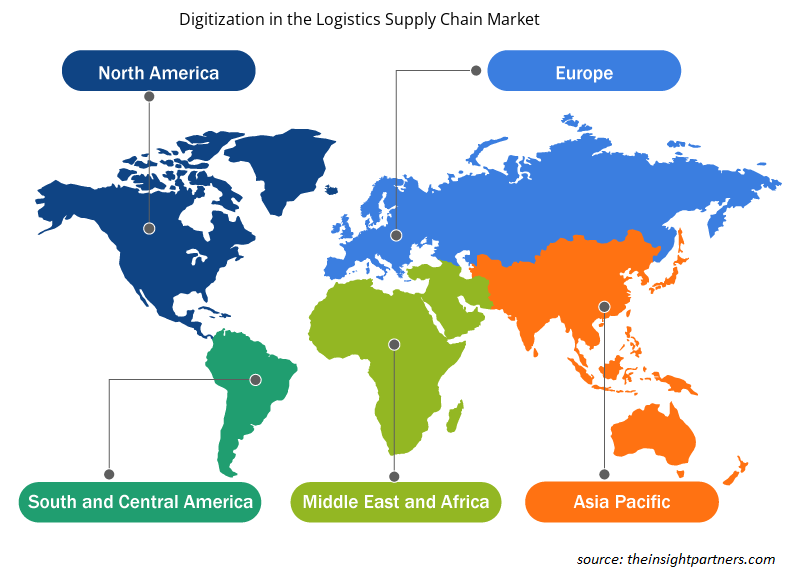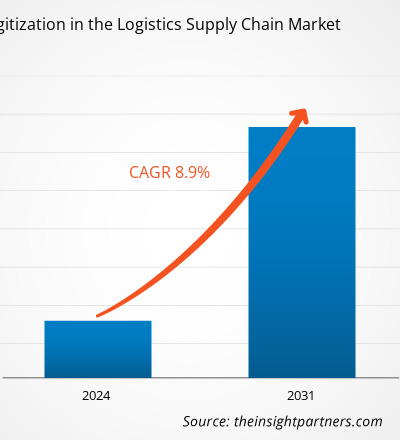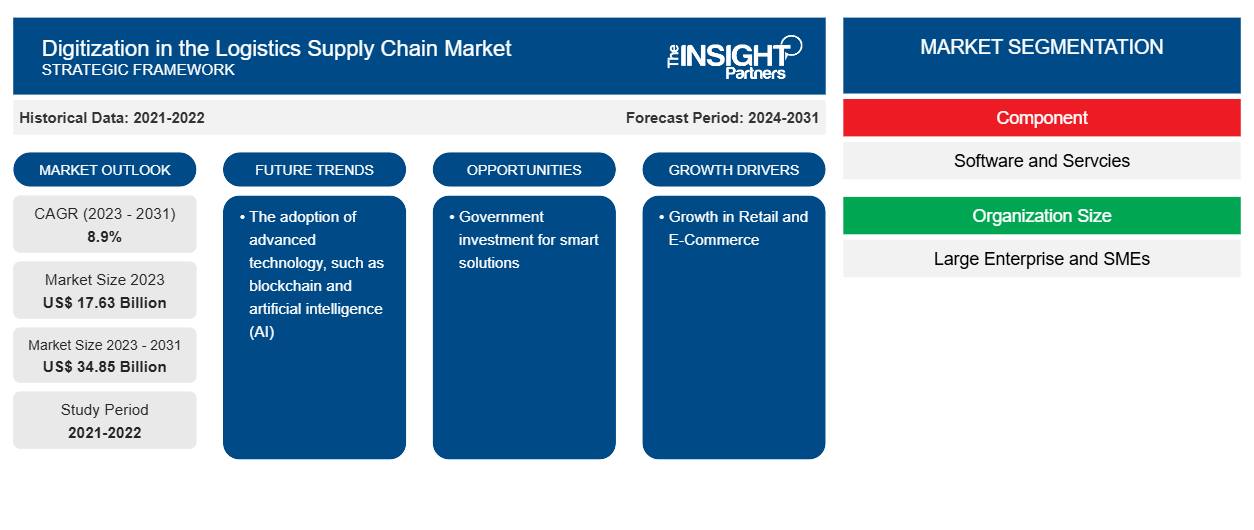Se prevé que la digitalización en el tamaño del mercado de la cadena de suministro logístico alcance los 34.850 millones de dólares en 2031, frente a los 17.630 millones de dólares en 2023. Se espera que el mercado registre una CAGR del 8,9 % entre 2023 y 2031. Es probable que la creciente demanda de gestión de la cadena de suministro y el aumento de la industria minorista y del comercio electrónico sigan siendo tendencias clave en el mercado de la cadena de suministro logístico.
Análisis del mercado de la digitalización en la cadena de suministro logística
La automatización en diversas industrias, como la automotriz, el comercio minorista y el comercio electrónico, la fabricación, la atención médica y otras, ha beneficiado a los operadores de estas industrias a gran escala al reducir los errores humanos. Por ejemplo, el comercio minorista en todo el mundo está creciendo continuamente y se espera que crezca más en el futuro. Por lo tanto, la creciente industria minorista se está enfocando en reducir los costos operativos totales al eliminar las operaciones manuales para el almacenamiento y la gestión de la cadena de suministro y la logística. La demanda de soluciones de automatización en toda la industria minorista impulsa el mercado. El sector de la logística en varias industrias está presenciando una transformación digital a medida que las partes interesadas se inclinan por minimizar los errores, mejorar las operaciones y la entrega a tiempo, lo que está impulsando el mercado.
Descripción general del mercado de la digitalización en la cadena de suministro logística
La transformación digital está cambiando los modelos de negocio tradicionales para hacerlos más eficaces y eficientes. La adopción de tecnologías digitales ayuda a los actores del mercado de diversas industrias a obtener una ventaja competitiva sobre los demás actores optimizando sus modelos de negocio. La digitalización de las operaciones de la cadena de suministro logístico les ayuda a ahorrar costes en mano de obra, agilizar sus procesos y minimizar los errores. La inclusión de tecnologías más avanzadas, como la inteligencia artificial (IA), les ayuda a tomar decisiones empresariales eficaces con análisis avanzados.
Personalice este informe según sus necesidades
Obtendrá personalización en cualquier informe, sin cargo, incluidas partes de este informe o análisis a nivel de país, paquete de datos de Excel, así como también grandes ofertas y descuentos para empresas emergentes y universidades.
-
Obtenga las principales tendencias clave del mercado de este informe.Esta muestra GRATUITA incluirá análisis de datos, desde tendencias del mercado hasta estimaciones y pronósticos.
Impulsores y oportunidades del mercado de la digitalización en la cadena de suministro logístico
El crecimiento del comercio minorista y el comercio electrónico favorecerán al mercado
El aumento de los ingresos y el poder adquisitivo de las personas ha sido un factor importante que ha impulsado el crecimiento de la industria minorista y del comercio electrónico. El aumento de la penetración de la telefonía móvil y de las conexiones a Internet ha proporcionado viabilidad y fácil accesibilidad a la industria minorista, lo que ha dado lugar al crecimiento de la industria del comercio electrónico. Según la India Brand Equity Foundation (IBEF), países como Estados Unidos, Canadá, Alemania, Reino Unido, China, Japón, Francia, Australia, Suiza, Italia e India se encuentran entre otros con un sólido mercado minorista. La digitalización en la cadena de suministro logístico ayuda a las partes interesadas de la cadena de suministro a optimizar sus operaciones. La digitalización ayuda al seguimiento y rastreo en tiempo real de los pedidos y las materias primas en la cadena de suministro. Ayuda a la coordinación eficiente entre los fabricantes, proveedores, distribuidores y minoristas para reducir los costes, aumentar la calidad y satisfacer las demandas de los clientes. Por tanto, el crecimiento del comercio minorista y electrónico impulsa la demanda de soluciones para mejorar la cadena de suministro y el flujo de trabajo logístico, lo que impulsa aún más la digitalización en el crecimiento del mercado de la cadena de suministro logístico.
Inversión gubernamental en soluciones inteligentes: una oportunidad de digitalización en el mercado de la cadena de suministro logística
Para promover la digitalización en todo el mundo, el gobierno está invirtiendo en soluciones inteligentes. La implementación de soluciones inteligentes ayuda a impulsar la producción, optimizar las operaciones y proporcionar un mayor retorno de la inversión. Ayuda a simplificar modelos comerciales complejos y a fomentar operaciones más rápidas.
- En septiembre de 2023, la administración Biden-Harris anunció 160 millones de dólares para tecnología de transporte inteligente. Esta inversión también se centró en la innovación de sistemas, como la entrega y la logística, las señales de tráfico, la red inteligente y la integración de datos.
- En febrero de 2023, el Ministro de Finanzas de la India anunció una asignación presupuestaria de aproximadamente 3363,5 millones de dólares (27 482 millones de rupias indias) para la Corporación de Corredores de Carga Dedicados de la India (DFCC), un aumento del 75 % en comparación con el año anterior. El discurso presupuestario destacó la priorización de 100 proyectos cruciales de infraestructura de transporte, como la entrega de última y primera milla para puertos, carbón, acero, fertilizantes y granos alimenticios.
De este modo, estas inversiones pueden impulsar la digitalización en el sector de la logística y la cadena de suministro y actuar como una oportunidad para el crecimiento del mercado.
Informe de mercado sobre digitalización en la cadena de suministro logística Análisis de segmentación
Los segmentos clave que contribuyeron a la derivación de la digitalización en el análisis del mercado de la cadena de suministro logístico son los componentes, el tamaño de la organización y la industria.
- En función de los componentes, el mercado se divide en software y servicios. El segmento de software tuvo una mayor participación de mercado en 2023.
- Por tamaño de organización, el mercado se segmenta en grandes empresas y pymes. El segmento de grandes empresas tuvo la mayor participación del mercado en 2023.
- Por industria, el mercado está segmentado en comercio minorista y comercio electrónico, atención médica, fabricación, automoción y otros. El segmento minorista y de comercio electrónico tuvo la mayor participación del mercado en 2023.
Análisis de la cuota de mercado de la digitalización en la cadena de suministro logística por geografía
El alcance geográfico de la digitalización en el informe del mercado de la cadena de suministro logístico se divide principalmente en cinco regiones: América del Norte, Asia Pacífico, Europa, Medio Oriente y África, y América del Sur/América del Sur y Central.
En términos de ingresos, América del Norte representó la mayor digitalización en la participación de mercado de la cadena de suministro logístico. Estados Unidos, Canadá y México se encuentran entre los países clave de América del Norte. La región es una de las primeras en adoptar soluciones tecnológicamente avanzadas, lo que es uno de los factores clave que impulsan el crecimiento del mercado. El auge de la industria minorista y del comercio electrónico en la región genera la demanda de soluciones digitales para optimizar la cadena de suministro y las actividades logísticas, lo que impulsa el mercado. Según el Departamento de Comercio de EE. UU., Las ventas minoristas y de servicios de alimentación en EE. UU. aumentaron un 0,6% en febrero de 2024 en comparación con enero de 2024. Además, según la Administración de Comercio Internacional, Canadá tenía alrededor del 75% de los usuarios de comercio electrónico de la población total de Canadá en 2022, lo que se espera que aumente al 77,6% para 2025. La gente en Canadá que compra cosas en línea está aumentando, lo que contribuye al aumento de las actividades de comercio electrónico del país, como las operaciones de entrega de productos.
Perspectivas regionales sobre la digitalización en el mercado de la cadena de suministro logístico
Los analistas de Insight Partners explicaron en detalle las tendencias y los factores regionales que influyen en el mercado de la digitalización en la cadena de suministro logístico durante el período de pronóstico. Esta sección también analiza los segmentos y la geografía del mercado de la digitalización en la cadena de suministro logístico en América del Norte, Europa, Asia Pacífico, Oriente Medio y África, y América del Sur y Central.

- Obtenga datos regionales específicos para la digitalización en el mercado de la cadena de suministro logística
Alcance del informe de mercado sobre digitalización en la cadena de suministro logístico
| Atributo del informe | Detalles |
|---|---|
| Tamaño del mercado en 2023 | US$ 17.63 mil millones |
| Tamaño del mercado en 2031 | US$ 34.85 mil millones |
| Tasa de crecimiento anual compuesta (CAGR) global (2023-2031) | 8,9% |
| Datos históricos | 2021-2022 |
| Período de pronóstico | 2024-2031 |
| Segmentos cubiertos |
Por componente
|
| Regiones y países cubiertos |
América del norte
|
| Líderes del mercado y perfiles de empresas clave |
|
La digitalización en la cadena de suministro logística: densidad de actores del mercado: comprensión de su impacto en la dinámica empresarial
El mercado de la digitalización en la cadena de suministro de logística está creciendo rápidamente, impulsado por la creciente demanda de los usuarios finales debido a factores como la evolución de las preferencias de los consumidores, los avances tecnológicos y una mayor conciencia de los beneficios del producto. A medida que aumenta la demanda, las empresas amplían sus ofertas, innovan para satisfacer las necesidades de los consumidores y aprovechan las tendencias emergentes, lo que impulsa aún más el crecimiento del mercado.
La densidad de actores del mercado se refiere a la distribución de las empresas o firmas que operan dentro de un mercado o industria en particular. Indica cuántos competidores (actores del mercado) están presentes en un espacio de mercado determinado en relación con su tamaño o valor total de mercado.
Las principales empresas que operan en el mercado de digitalización en la cadena de suministro logística son:
- SAP SE
- Corporación Oracle
- IBM
- Corporación Intel
- Información
- Tecnologías Hexaware Limitada
Descargo de responsabilidad : Las empresas enumeradas anteriormente no están clasificadas en ningún orden particular.

- Obtenga una descripción general de los principales actores clave del mercado de la digitalización en la cadena de suministro logístico
Noticias y desarrollos recientes sobre la digitalización en la cadena de suministro logística
La digitalización en el mercado de la cadena de suministro logístico se evalúa mediante la recopilación de datos cualitativos y cuantitativos a partir de investigaciones primarias y secundarias, que incluyen publicaciones corporativas importantes, datos de asociaciones y bases de datos. A continuación, se incluye una lista de los avances en el mercado:
- En diciembre de 2023, Fujitsu anunció el lanzamiento de un nuevo servicio de estandarización y visualización de datos logísticos basado en la nube para transportistas, empresas de logística y proveedores de toda la cadena de suministro. El servicio ofrece nuevas herramientas a los clientes para lograr la sostenibilidad en sus operaciones y abordar una variedad de desafíos, incluida la inminente escasez de conductores de camiones, la urgente necesidad de reducir la huella de carbono del transporte y el cumplimiento de regulaciones industriales más estrictas. (Fuente: Fujitsu, comunicado de prensa, 2023)
- En enero de 2024, Blue Yonder, un proveedor líder de soluciones para la cadena de suministro, anunció el lanzamiento de la mayor actualización de productos en la historia de la empresa y lanzó el primer conjunto de soluciones interoperables en toda la cadena de suministro (desde la planificación hasta el almacén, el transporte y el comercio) que se entregan en la plataforma cognitiva Luminate de la empresa. La apuesta por la interoperabilidad le permite a Blue Yonder ofrecer a sus clientes una mayor productividad, menos desperdicios y cadenas de suministro más resilientes. (Fuente: Blue Yonder, comunicado de prensa, 2024)
Informe de mercado sobre digitalización en la cadena de suministro logística: cobertura y resultados
El informe “Tamaño y pronóstico del mercado de digitalización en la cadena de suministro logística (2021-2031)” proporciona un análisis detallado del mercado que cubre las siguientes áreas:
- Tamaño del mercado y pronóstico a nivel global, regional y nacional para todos los segmentos clave del mercado cubiertos bajo el alcance
- Dinámica del mercado, como impulsores, restricciones y oportunidades clave
- Principales tendencias futuras
- Análisis detallado de las cinco fuerzas de Porter y PEST y FODA
- Análisis del mercado global y regional que cubre las tendencias clave del mercado, los principales actores, las regulaciones y los desarrollos recientes del mercado.
- Análisis del panorama de la industria y de la competencia que abarca la concentración del mercado, el análisis de mapas de calor, los actores destacados y los desarrollos recientes
- Perfiles detallados de empresas
- Análisis histórico (2 años), año base, pronóstico (7 años) con CAGR
- Análisis PEST y FODA
- Tamaño del mercado, valor/volumen: global, regional y nacional
- Industria y panorama competitivo
- Conjunto de datos de Excel
Informes recientes
Informes relacionados
Testimonios
Razón para comprar
- Toma de decisiones informada
- Comprensión de la dinámica del mercado
- Análisis competitivo
- Información sobre clientes
- Pronósticos del mercado
- Mitigación de riesgos
- Planificación estratégica
- Justificación de la inversión
- Identificación de mercados emergentes
- Mejora de las estrategias de marketing
- Impulso de la eficiencia operativa
- Alineación con las tendencias regulatorias























 Obtenga una muestra gratuita para - Digitalización en el mercado de la cadena de suministro logística
Obtenga una muestra gratuita para - Digitalización en el mercado de la cadena de suministro logística